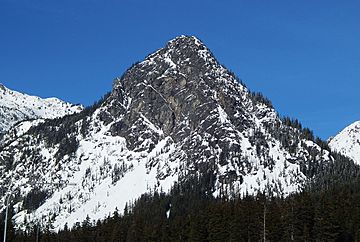Guye Peak facts for kids
Quick facts for kids Guye Peak |
|
|---|---|

South aspect from Snoqualmie Pass
|
|
| Highest point | |
| Elevation | 5,168 ft (1,575 m) NGVD 29 |
| Prominence | 528 ft (161 m) |
| Isolation | 1.12 mi (1.80 km) |
| Parent peak | Kendall Peak (5,784 ft) |
| Geography | |
| Location | King County, Washington, U.S. |
| Parent range | Cascade Range |
| Topo map | USGS Snoqualmie Pass |
| Climbing | |
| Easiest route | Exposed Scramble, class 3 |
Guye Peak is a mountain located in Washington state, United States. It was named after Francis M. Guye, who had an iron mining claim there in the 1880s. This peak is part of the Alpine Lakes Wilderness area within the Cascade Range. It stands tall, looking over Snoqualmie Pass from the north side.
Guye Peak was first climbed on October 6, 1912. The climbing team included Charles Hazlehurst, Hector Abel, Paul Dubuar, and Mary Hard. The climb from the pass valley is about 2,000 feet (610 meters) high. It involves a mix of rock climbing and scrambling, with difficulties ranging from easy (YDS 3) to more challenging (YDS 5.6). Many people enjoy climbing Guye Peak because it's easy to get to from Interstate 90.
Like other outdoor adventures in this area, Guye Peak has some challenges. In summer, rocks can be slippery due to moss or wet conditions. In winter, there's a risk of avalanches. Climbing any mountain requires skill and caution. It's important to be prepared and aware of the risks, as accidents can happen.
How Guye Peak Was Formed
The Alpine Lakes Wilderness is known for its amazing landscape. You'll find jagged peaks, sharp ridges, and deep valleys carved by glaciers. There are also huge granite walls and over 700 mountain lakes. These features were created by geological events that happened millions of years ago. These events led to the big changes in elevation and different climates across the Cascade Range.
The Cascade Mountains started forming millions of years ago, during the late Eocene Epoch. This happened as the North American Plate slowly moved over the Pacific Plate. This movement caused many periods of volcanic activity. Also, small pieces of the Earth's crust, called terranes, helped create the North Cascades about 50 million years ago.
During the Pleistocene period, over two million years ago, glaciers played a huge role. They moved forward and backward many times, shaping the land. The last time glaciers retreated from the Alpine Lakes area was about 14,000 years ago. They had moved north of the Canada–US border by 10,000 years ago. The river valleys in this area have a "U" shape. This shape is a clear sign of past glaciation. The combination of land rising (uplift) and cracks in the Earth's crust (faulting), along with glaciation, created the tall peaks and deep valleys we see today.
Weather and Climate
Guye Peak is located in a marine west coast climate zone in western North America. This means it gets a lot of moisture from the Pacific Ocean. Most weather fronts start in the Pacific and travel northeast towards the Cascade Range.
As these weather fronts hit the tall peaks of the Cascade Range, they are forced upwards. This process is called Orographic lift. When the air rises, it cools down and drops its moisture. This results in lots of rain or snowfall on the western side of the Cascades. Because of this, the west side of the North Cascades gets a lot of precipitation, especially snow in winter.
Thanks to the mild ocean influence, temperatures rarely go below 0°F (-18°C) or above 80°F (27°C) west of the Cascade Crest. In winter, the weather is usually cloudy. However, during summer, high-pressure systems over the Pacific Ocean often bring clear skies. Because of the ocean's influence, the snow tends to be wet and heavy. This can lead to a high risk of avalanches. The best months to visit or climb Guye Peak are usually July through September.




